Night Photography
by Michael Frye | May 17, 2022 | Night Photography, Travels and Stories
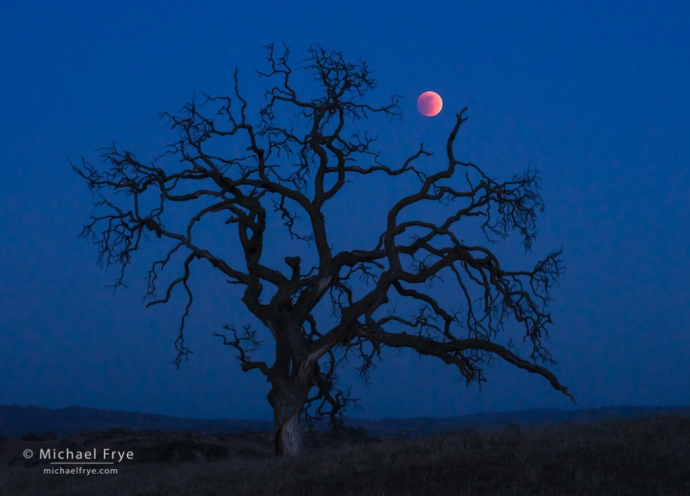
Blue oak and eclipsed moon, Sierra Nevada foothills, California. 122mm, 1 second at f/11, ISO 6400.
On Sunday a total lunar eclipse was visible in many parts of the world, including our corner of California in the Sierra Nevada.
I’ve photographed many lunar eclipses before. I like capturing sequences of the moon above a landscape in various eclipse stages – if possible. But for this eclipse I couldn’t think of any nearby spot that would add a compelling foreground while looking in the right direction (southeast) for a sequence like that, plus it appeared that clouds might interrupt any attempt at capturing a long eclipse sequence.
Instead, I thought of a lone oak tree in the Sierra foothills that might lend itself to a different treatment: a telephoto view of just the tree and eclipsed moon at dusk. I had photographed this tree before, and it looked like the tree and moon would line up well. Using a long lens would make the moon look larger, plus capturing a single frame like this would require only a brief cloud-free interval to work, while a sequence would need several hours of clear skies.
(more…)
by Michael Frye | Aug 15, 2021 | Night Photography
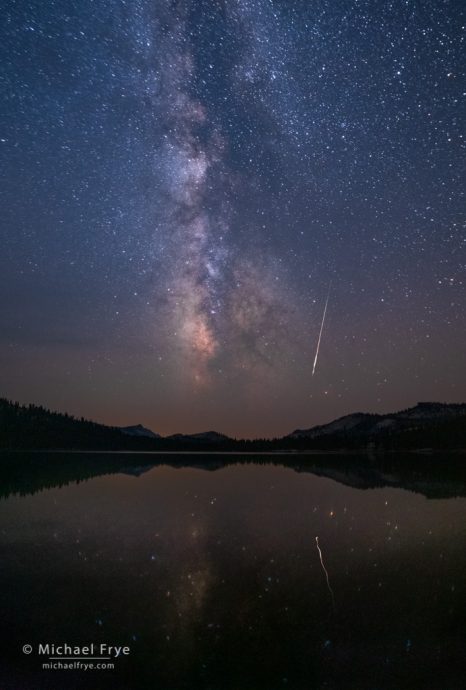
Milky Way and meteor reflected in an alpine lake, Yosemite NP, California. The meteor’s reflection is squiggly because the water was slightly rippled. I blended 20 exposures (each 16mm, 30 seconds at f/4, ISO 6400) with Starry Landscape Stacker to reduce noise. That kind of blending wipes out short-lived light sources, like car headlights or jet trails, which is usually a great thing. But in this case it also wiped out the meteor and its reflection, so I took that one meteor frame into Photoshop, and blended it with the TIFF output from Starry Landscape Stacker to create the final image.
On Thursday evening Claudia and I decided to head up to Yosemite to watch the Perseid meteor shower. Although you can see more Perseid meteors during the early-morning hours, we knew from previous experience that those early-morning meteors rain down from directly overhead, so although numerous, their paths are short. But during the evening you’re much more likely to see an “earth-grazer” – a meteor that glances across the atmosphere at an angle, making a long, bright streak through the sky. So although evening meteors are less abundant, the ones you do see are often more spectacular.
We made our way to a high-country lake. I set up my camera, then we laid out our stadium chairs to watch the show. Only it wasn’t much of a show at first. For a long time we saw no meteors whatsoever, earth-grazers or otherwise. Finally we saw some small ones. And then, eventually, I saw a big, bright, beautiful earth-grazer streak across half the sky. But Claudia missed it. Eventually we saw a few more earth-grazers, though none as bright as that first one.
(more…)
by Michael Frye | May 23, 2021 | Night Photography, Reviews
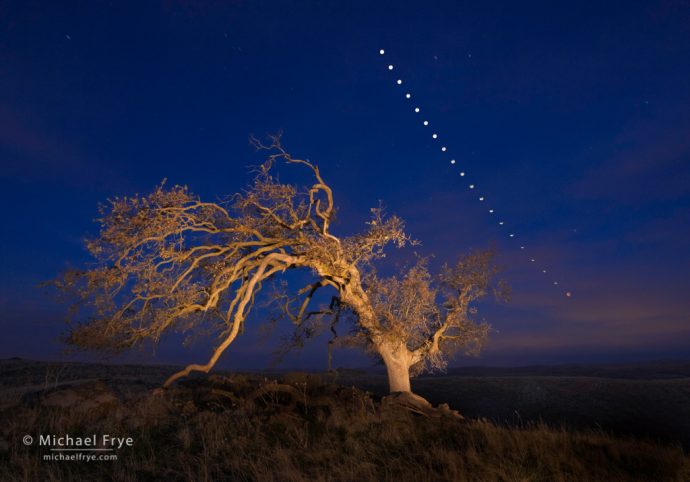
Oak tree and lunar eclipse sequence, December 10th, 2011, Mariposa County, Sierra foothills, California. In this sequence, the moon was setting to the west-northwest just before sunrise. In the upcoming eclipse, the moon will also be setting just before sunrise for viewers in the western U.S. – but to the southwest. (Click here to read the story behind this photo.)
In case you haven’t heard, there’s going to be a total lunar eclipse this week in some parts of the world. That includes western North and South America, Australia, New Zealand, and eastern Asia. You can see all the places where the eclipse will be visible on timeanddate.com.
The total eclipse will last about 14 minutes, from 11:11 to 11:25 UTC (Universal Time) on Wednesday, May 26th. That translates to 4:11 to 4:25 a.m. Wednesday here in California. The partial eclipse begins at 9:44 UTC, and ends at 12:52 UTC (2:44 a.m. and 5:52 a.m. Pacific Time).
(more…)
by Michael Frye | Feb 7, 2021 | Night Photography
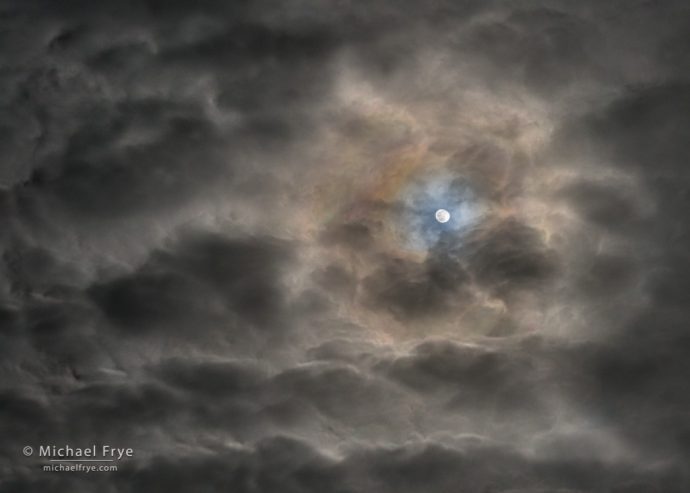
Moonlit clouds, Sierra Nevada, California. 70mm, three bracketed frames, two stops apart, each at f/5.6, ISO 800, blended with Lightroom’s HDR Merge.
Every so often I’ll be outside at night and see some interesting clouds passing in front of the moon. This can be quite a beautiful sight, especially with a pattern of small, puffy clouds stretching across the sky. And under these conditions you can often see a rainbow-like corona around the moon.
I’ve tried to photograph moonlit clouds like this a few times, with mixed results. Usually by the time I get out my camera, find a suitable viewpoint, compose, focus, and figure out an exposure, the clouds are gone – or at least less interesting.
(more…)
by Michael Frye | Aug 30, 2020 | Light and Weather, Night Photography
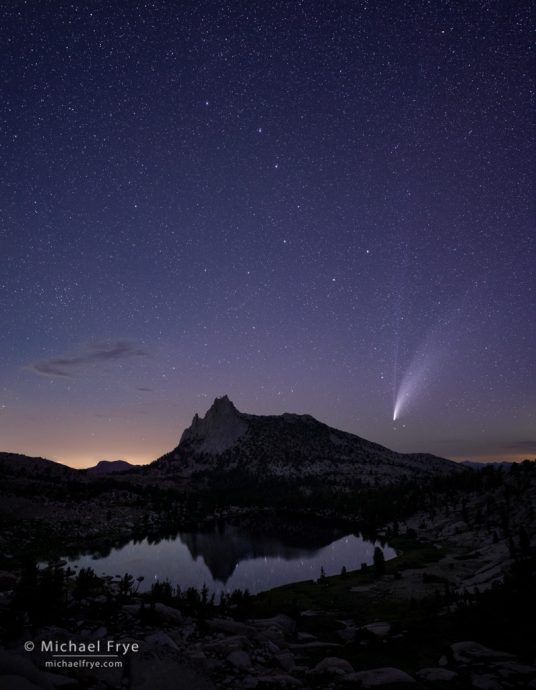
The Big Dipper and Comet NEOWISE over an alpine lake, Yosemite. 9 frames blended with Starry Landscape Stacker to reduce noise, each at 15 seconds, f/1.8, ISO 6400. I also made a lighter exposure for the landscape at 2 minutes and f/1.8, ISO 6400, and blended that with the other frames in Photoshop. All that was done just to reduce noise. The camera was locked on a tripod throughout that process, and nothing was stretched, distorted, or added. In other words, the comet and stars really were there, in that exact position over the lake and peak, at 11:06 p.m. on July 18th.
Before my journey to Death Valley, Claudia and I made a couple of trips to the Yosemite high country to try to photograph Comet NEOWISE.
On our first attempt we hiked to a high, alpine lake where I thought we could get a good view of the comet. It was one of those summer days in the Sierra with lots of clouds building up and forming scattered thunderstorms. I knew the clouds might interfere with comet viewing, but with that weather pattern the clouds usually dissipate quickly after sunset, so it seemed worth a try. And maybe the clouds would give us an interesting sunset.
(more…)
by Michael Frye | Aug 2, 2020 | Night Photography, Travels and Stories
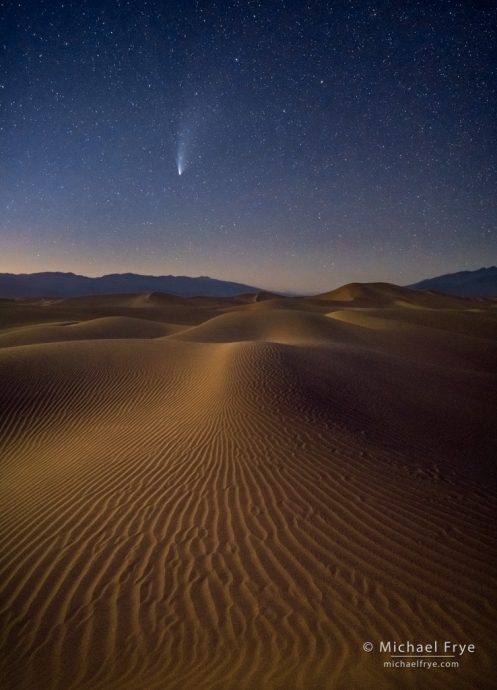
Comet NEOWISE over moonlit sand dunes, Death Valley. 20mm, 16 frames blended to reduce noise, each frame 15 seconds at f/2.4, ISO 6400.
I knew it would be hot. It was July, after all, and Death Valley is perhaps the hottest place on earth. But I was actually lucky; summer temperatures in Death Valley often climb above 120 degrees Fahrenheit, while the high temp on the day I was there was only 113. Practically a cold snap.
What was I doing in Death Valley in July? Photographing Comet NEOWISE of course. I know the internet has been flooded by comet images lately, but I totally get it. The last really photogenic comet visible in the northern hemisphere was Hale-Bopp in 1997. Who knows when we’ll see another one?
(more…)














